If you’re looking for an interesting houseplant that is easy to care for, low-maintenance, and will still provide the room with interest and texture, look no further than the Philodendron giganteum.
This plant produces extremely large foliage that can quickly fill up an unused corner in your living room or bare space in your dining room.
No matter where you place the Philodendron giganteum, it will be sure to give you years of enjoyment as long as you provide it with the proper care.
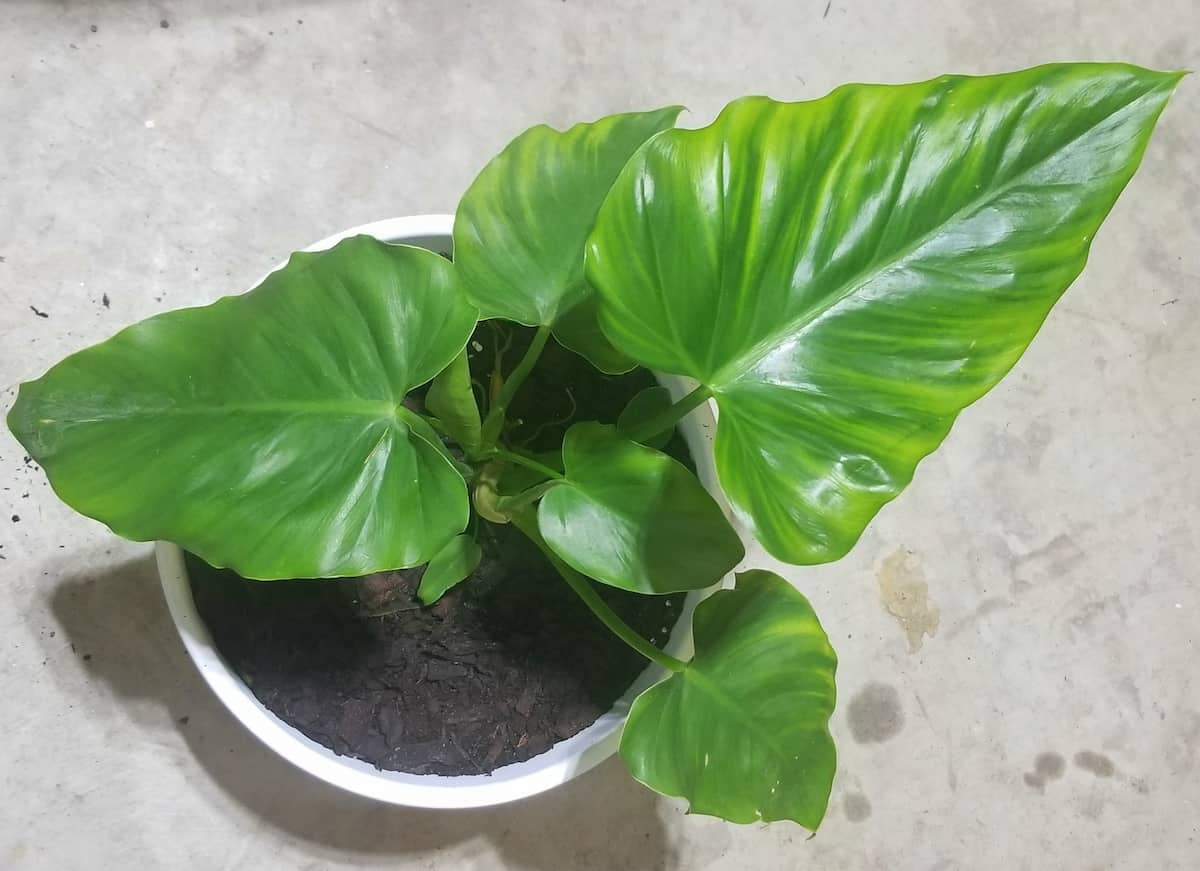
Table of Contents
How do you care for a philodendron giganteum?
The best way to care for a Philodendron giganteum is to try and emulate its natural, tropical environment as closely as possible. This involves providing it with bright, indirect light, plenty of warmth and humidity, well-draining soil, good hydration, and seasonal feeding. Occasional pruning and cleaning also help your Philodendron Birkin’ overall well-being.
Philodendron giganteum make great houseplants, and if you have any hesitation about their care, worry no further. These gracious green beauties are low-maintenance and straightforward in terms of their needs, making them perfect for even beginner plant parents.
Bearing in mind that Philodendron giganteum are tropical plants, the best environment you can offer them is one where they’ll have a sunny spot with lots of light, relative humidity, and plenty of moisture.
1. Grow the plant in temperatures between 55 and 80 degrees
Philodendron giganteum is native to tropical climates and doesn’t do well in cold temperatures. That is why it is important to ensure the plant isn’t subjected to temps lower than 55 degrees.
Additionally, make sure you keep the plant away from areas where the temperature fluctuates rapidly.
2. Keep humidity at 60 percent or above
The Philodendron giganteum needs high levels of humidity and you should aim to provide it with at least 60 percent humidity levels.
This can be done with the use of a drip tray or humidifier. Additionally, you may have to mist the plant every so often during the winter months.
3. Keep philodendron giganteum out of full sun
Full sun or direct sunlight will quickly burn and scorch the foliage of the Philodendron giganteum. And since this plant is grown for its stunning, large leaves, you can quickly see why this would cause a problem.
Instead, select a place where the Philodendron giganteum will get bright, but indirect light.
Find out more: Philodendron Light Needs: The Ultimate Guide
4. Plant the philodendron giganteum in loose soil
Like most other houseplants, the Philodendron giganteum needs soil that is loose, airy and drains well. Avoid planting it in compact soil that holds in too much moisture as this can lead to root rot.
Additionally, you should add organic matter, such as peat moss, to the soil to help increase its nutrient content.
Top pick: My preferred soil for philodendrons is the Miracle-Gro Tropical Potting Mix (check the latest price here).
It’s very well draining and will feed nutrients to your philodendron for up to six months. For a tropical plant like the philodendron, it’s got everything you need.
5. Water when the top two inches of soil feels dry
Philodendron giganteum cannot tolerate drought conditions, nor do they like their feet to stay soggy. This means you will need to find the right balance between too much water and not enough. Thankfully, this can be done by only watering your philodendron when the top two inches of soil feels dry.
To test the soil, simply insert your finger into the soil and feel the moisture level. If the soil feels dry, go ahead and water it deeply. If, however, it still feels moist, wait a day or two and check the soil dryness once more.
6. Feed the philodendron giganteum twice a month
Philodendron giganteum is a plant that likes a little bit of food every now and again. In fact, they do their best when they are fed twice a month during their active growing season, which is the spring and summer. Use an all-purpose liquid fertilizer at half strength.
Stop all feeding when the Philodendron goes into its dormant period, which is during the fall and winter. Feeding the plant during this time can interfere with its natural growing cycle.
My top pick: My recommendation for the best fertilizer for your philodendron is EZ-Gro 20-20-20 All Purpose Liquid Fertilizer.
It’s extremely easy to use and has the perfect balance of nutrients for philodendrons. You can check the latest price here.
7. Grow the philodendron giganteum in a pot with drainage holes at the bottom.
The exact material the pot is made from isn’t as important as ensuring the pot has proper drainage holes.
Avoid using pots with holes in the sides, since the water will have to reach that point before it can drain out. This increases the chance of soggy roots. Instead, use a pot that has drainage holes at the very bottom.
8. Philodendron giganteum only needs pruning to remove dead and damaged foliage
Philodendron giganteum doesn’t like regular pruning, but it will benefit from snipping off any dead and damaged foliage or stems. Use a pair of sharp and clean pruning shears to remove the damaged portions, making sure to cut right above a leaf node.
Keep in mind that you should only prune the Philodendron giganteum when it is mature, since pruning young plants can damage them. Additionally, prune your philodendron only during the spring and early summer months since this is when the plant is actively growing.

9. Watch for sap-sucking insects that can attack the philodendron giganteum
Philodendron giganteum is not immune to sap-sucking insects, which can attack just about any houseplant. Spider Mites, mealybugs, scales, and aphids can all feast on the Philodendron giganteum.
The good news is that these plants are more of a nuisance than a serious problem, and unless the infestation is extreme, it won’t cause long-term damage to the plant.
Regular inspection of the plant will help you catch pest infestations before they get out of control. If you notice any sap-sucking insects, treat with insecticidal soap or neem oil, making sure to follow the instructions listed on the bottle.
10. Avoid overwatering the philodendron giganteum since this can quickly kill the plant
Philodendron giganteum is prone to root rot, which occurs when you overwater the plant. To make matters worse, root rot can quickly kill the Philodendron giganteum. The good news is that root rot in philodendrons is preventable with proper care.
The best way to keep root rot at bay is to only water the plant when the first one to two inches of soil are dry. Additionally, make sure the Philodendron is growing in soil that drains well. Compact and poor draining soil can increase the chance of fungal diseases, such as root rot.
11. Only transplant philodendron giganteum when the roots start to grow out of the drainage holes
Philodendron giganteum is not a plant that needs to be repotted regularly. In fact, this plant does well when it is rootbound. With that said, however, you should repot your philodendron if you see roots growing out of the drainage holes.
When you do transplant the Philodendron, do so in spring before the plant starts to produce new growth, and select a pot that is about 3 sizes larger than the current pot. Alternatively, you can wait until fall to perform the transplant.

12. Propagating philodendron giganteum can be difficult, but not impossible
Propagating the Philodendron giganteum is not as easy as propagating other Philodendron varieties, since it can take a long time for a cutting to root.
But if you have a mature Philodendron giganteum in your collection, you may be able to start a new plant if your mature Philodendron has developed a plantlet.
It is best to allow the plantlet to continue to grow on the parent plant until its stem is visible, but this can take several months. Alternatively, the Philodendron giganteum can be propagated via the air layering method.
How can I propagate philodendron giganteum?
Propagating Philodendron giganteum is a bit more difficult than propagating other houseplants, and will require using the air layering method.
This is done by cutting the stem of the plant in a ring-like manner and then wrapping moist sphagnum moss around the wound, making sure to keep it in place with plastic wrap.
- Select a healthy stem that you will propagate from, making sure it has several leaves growing on it. Girdle the middle of the stem in a circular manner.
- Remove and discard the leaves around and near the wound.
- Dampen sphagnum moss and then pack it around and into the wound. Alternatively, use peat moss instead of sphagnum moss.
- Secure the moss in place with polyethylene plastic, and then secure the ends of the plastic with plant/gardening tape.
- Regularly check the moss to ensure it stays moist. If the moss begins to dry out, moisten it and then secure it once again with plastic and tape.
- Once roots start to form from the wound, cut the stem from the parent plant and then plant in its own pot. Care for the young plant as you normally would.
Air layering is more complicated than simply propagating via stem or leaf cutting. However, you are more likely to be successful with the propagation using this method over the easier methods. This is because the Philodendron giganteum doesn’t root easily using the stem or cutting method, which is the usual way of propagating philodendron plants.
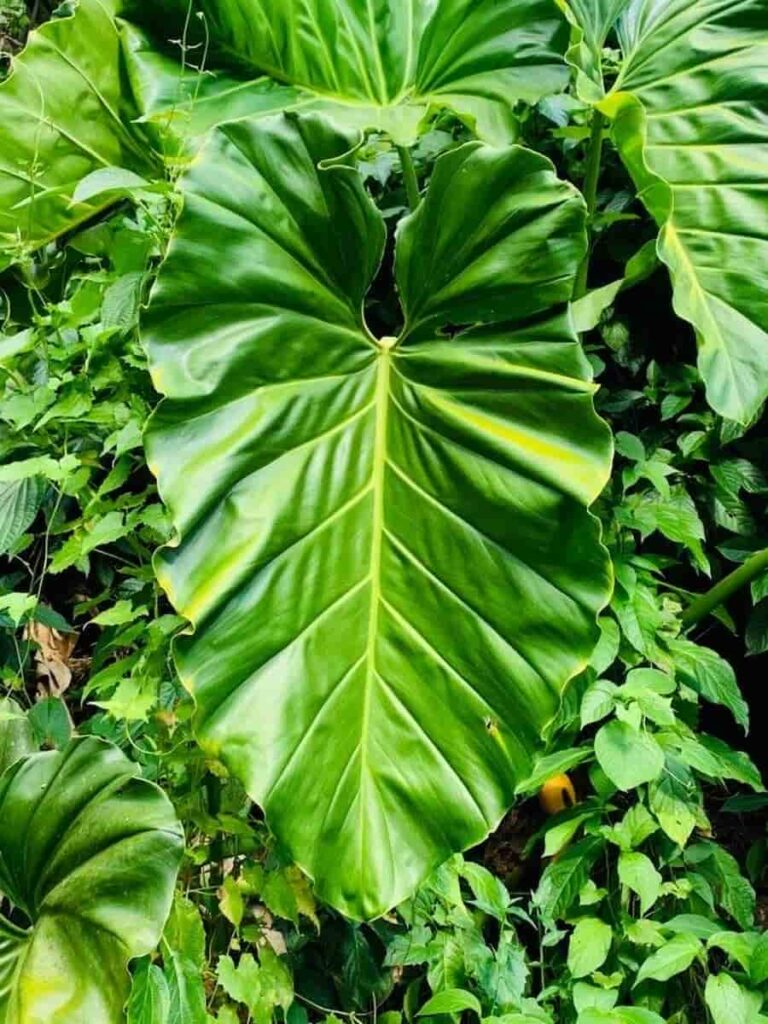
Is philodendron giganteum rare?
Philodendron giganteum is not considered rare and is readily available at garden centers and nurseries. The variegated variety of this plant, however, is considered rare. Variegated philodendron giganteum features splashy green foliage and can reach several feet across. This makes it in quite high demand, often causing supply shortages.
Philodendron giganteum is commonly found growing on trees in its native habitat, but it is readily available to purchase as a houseplant. In fact, the Philodendron giganteum is a common sight in garden centers, and can be purchased from various nurseries and online merchants.
Where can I buy philodendron giganteum?
Philodendron giganteum is not a hard plant to come by, and is actually available to purchase from a wide array of stores. In fact, your local nursery or garden center may even have this plant in stock. If not, Philodendron giganteum can be ordered online from many different merchants.
If you’re a member of a local plant group, reach out to other members to see if anyone has a young Philodendron giganteum they can sell you. This is a great way to obtain a plant from someone who you trust, which means you are sure to get a quality Philodendron.

What’s a standard philodendron giganteum price?
The standard price for a Philodendron giganteum will vary depending on the age and size of the plant. For example, you can purchase a small Philodendron giganteum in a four foot pot for about $30, while a larger and more mature Philodendron giganteum can cost a few hundred dollars.
If you’re on a budget, consider reaching out to local gardening groups to see if they offer Philodendron giganteum cuttings. This can be a great way to not only get a cutting for little to no cost, but to also connect to other gardeners in your area.
Does philodendron giganteum grow fast?
Philodendron giganteum is known to have a fast growth rate, and some growers even remark that it seems like the plant’s foliage gets larger every single day. However, you will need to ensure the Philodendron giganteum has its ideal growing requirements in order to promote healthy and quick growth.
If not, the plant will experience slowed and even stunted growth.
Find out more: What is a Philodendron’s Growth Rate (+ How To Grow It Faster)?
Can I grow philodendron giganteum from seeds?
While it’s not impossible to grow Philodendron giganteum from seeds, it can be a time-consuming and painstaking task. Because of this, most gardeners choose to propagate the Philodendron giganteum using either air layering or via plantlets, both of which are quicker and more reliable methods.
Keep in mind, however, that the Philodendron giganteum grows from a central system and can keep its bushy shape for many years before it extends out long enough for you to propagate this plant. Once this occurs, however, you can more easily propagate your Philodendron.
Is philodendron giganteum a climber or crawler?
Philodendron giganteum is more of a climbing plant that has aerial roots that help it adhere to vertical surfaces. In its native habitat, the Philodendron giganteum is often seen growing up tall trees. That doesn’t mean that you won’t see this plant growing on the ground.
While it may prefer grasping onto a tree and climbing up, the Philodendron giganteum is also sometimes found growing with a bush-like form.
How big does a philodendron giganteum get?
On average, the Philodendron giganteum can produce leaves that measure about 5 feet tall and 3 feet across. However, the actual size that Philodendron giganteum can get varies on several factors, including its growing habitat and how well it is cared for.
The best way to ensure your Philodendron giganteum grows as big and strong as possible is to give it the right care. This means ensuring it is growing in the proper pot, the right soil for philodendron plants, and in the ideal light, temperature, and humidity conditions.
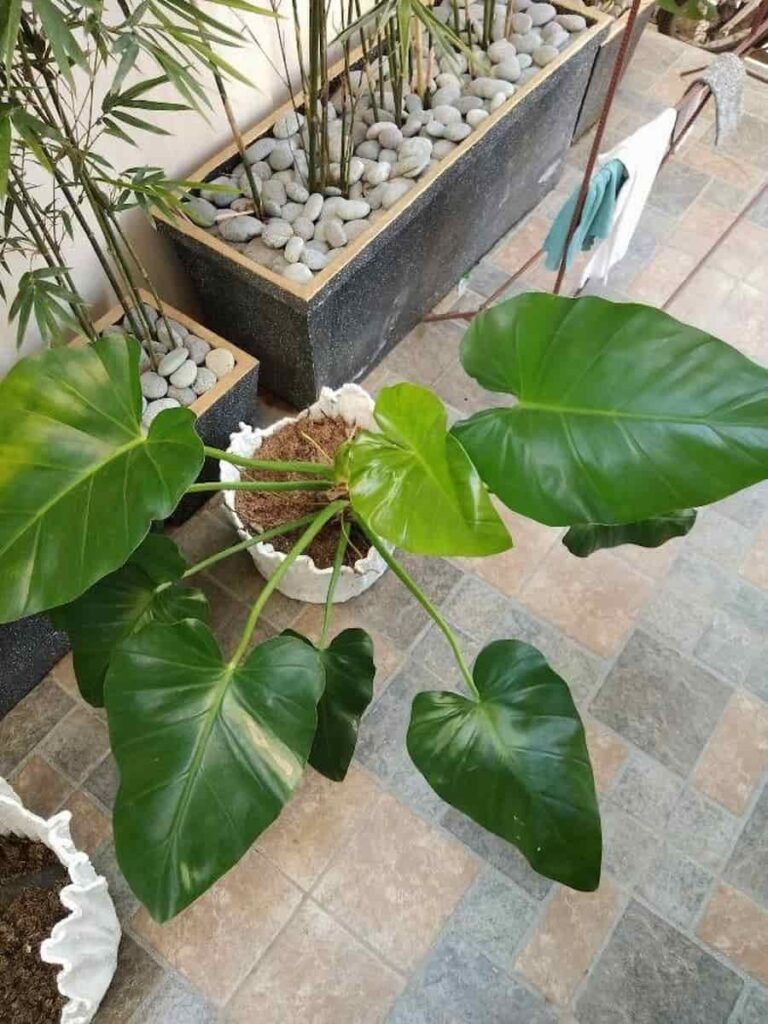
What are the philodendron giganteum varieties?
While there are hundreds of different Philodendron cultivars available, there are only a few different Philodendron giganteum varieties out there. Knowing the different Philodendron giganteum varieties can help you make a better choice of which one to grow.
- Philodendron giganteum ‘Elephant Ear’ – The Elephant Ear variety of Philodendron giganteum is actually two Philodendron giganteum plants grown in the same pot, which gives it the appearance of an elephant’s ear.
- Philodendron giganteum ‘Blizzard’ – Blizzard is a variegated Philodendron giganteum that produces light green foliage that is marbled in stripes of light yellow hues.
- Philodendron giganteum ‘Variegata’ – Philodendron giganteum ‘Variegata’ is another variegated varieiy of the Philodendron giganteum. Like ‘Blizzard’, ‘Variegata’ produces the same large Philodendron giganteum leaves. Only theirs features a streaky pattern of yellow, cream, and white variegation.
Related: 106 Popular Philodendron Types (Best Varieties For Your Home)
Is philodendron giganteum toxic?
Philodendron giganteum is, unfortunately, toxic to humans and pets. This plant contains calcium oxalate crystals, which can cause serious and painful side effects if ingested. Consuming any part of the Philodendron giganteum can lead to irritation and pain in the mouth, tongue, throat, and lips, as well as difficulty breathing and swallowing, and gastrointestinal distress.
This is why, if you have any kids or pets at home, you will want to make sure that the plant is out of reach, especially if they’re prone to chewing on the nearest leaf.
Be aware: If any human or your pet in your household has ingested Philodendron giganteum, seek medical attention immediately. While most symptoms subside in a day or two, it’s best to err on the side of caution since consuming Philodendron giganteum can, in extreme cases, lead to organ failure, especially in dogs and cats.
How do I make philodendron giganteum look fuller?
Pruning is typically how you make a plant look fuller, but the Philodendron giganteum doesn’t take too kindly to pruning. Instead, apply a fertilizer designed to promote foliage growth. Because of the sheer size of the Philodendron giganteum leaves, it only takes a few leaves to make the plant look much fuller than it actually is.
Additionally, if you want your Philodendron giganteum to look fuller, you will need to ensure the plant receives the best care possible. A Philodendron that is properly cared for will have a healthy and full appearance.
Find out more: 6 Easy Steps to Make Your Philodendron Fuller and Bushier
Should I mist philodendron giganteum?
Misting the Philodendron giganteum is a wonderful way to help push the humidity up to its ideal level, while also keeping the plant clean and dust-free. Just make sure not to overmist the plant, which can cause soggy soil and lead to a slew of potential harmful plant diseases.
While misting can help the Philodendron giganteum, you shouldn’t use it as a way to increase the humidity level of the plant. Instead, use a drip tray or humidifier to address the low humidity problem.
If you must use misting as a way to increase humidity, always wipe the leaves with a soft cloth after misting them. Wiping the leaves helps to get rid of excess moisture which can lead to problems, while also cleaning dust from the leaves.
Why are my philodendron giganteum’s leaves curling?
Underwatering is the most common cause of the Philodendron giganteum leaves curling. When the plant becomes too dry, the foliage will start to discolor yellow or brown and the edges will begin to curl. The entire plant may also start to wilt and leaf drop can occur.
The best way to determine if the Philodendron giganteum is underwatered is by checking the soil. Extremely dry soil will start to pull away from the pot and just feel dry and crumbly, making it a clear sign of why your philodendron leaves are curling.
The good news is that you can correct this problem by giving the Philodendron giganteum a good soak in water for about 30 minutes.

Frequently asked philodendron giganteum questions
When growing Philodendron giganteum, it is not uncommon for some questions to arise. Questions such as why its leaves are discolored, what could cause the plant to not grow as fast as it should, and why there are brown spots on the Philodendron’s foliage. Thankfully, the following FAQ can help guide you through the most commonly asked questions.
Why are my philodendron giganteum leaves turning brown?
Philodendron giganteum can develop brown leaves if it is not getting the proper amount of water or humidity. In most cases, the brown leaves will also start to feel dry and crispy, and the entire plant may start to wilt.
Thankfully, if you’ve noticed your philodendron leaves turning brown in time, the issue is fairly easy to fix by allowing the plant to soak in water for 20 to 30 minutes.
What would cause my philodendron giganteum to start yellowing?
There are several reasons as to why your Philodendron giganteum is yellowing. The most common cause, however, is overwatering. Overwatering the plant interferes with its ability to properly absorb nutrients from the soil, while also increasing the chance of root rot.
The best way to control this problem is by simply watering the plant only when the top two inches of soil is dry. If, however, overwatering has already led to root rot, trying to reverse the issue can be difficult.
Related: 12 Causes of a Philodendron’s Yellow Leaves (+ How to Fix It)
How do I get rid of brown spots on my philodendron giganteum?
Various fungal and bacterial diseases, such as leaf spot, can cause brown or yellow spots to appear on the foliage and even stems of the Philodendron giganteum. While these can be difficult to treat, they typically won’t kill the plant. Applying a copper fungicide to the Philodendron can help control leaf spots.
Like most issues, catching the fact that your philodendron has brown spots as early as possible is critical to making sure this doesn’t affect your plant too badly.
Why is my philodendron giganteum not growing?
Slowed or stunted growth is most often caused by low light. While the Philodendron giganteum will burn in direct sunlight, it does still need light in order to grow properly. If your Philodendron isn’t growing as it should, try moving it to a location where it will get bright light without being in full or direct sun.
Of course, any time your philodendron isn’t growing is cause for further investigation, which will usually come down to a process of elimination.
What can I do about gnats around my philodendron giganteum?
While the adult fungus gnats don’t feed on Philodendron, they do lay their eggs in the soggy soil of houseplants and their larvae can quickly destroy the plant’s roots. If you’re seeing fungus gnats around your plant, reducing the watering can help get rid of them.
If they are still a problem, you can kill the larvae by combining 4 cups of water with 1 cup of hydrogen peroxide (3% strength) and then spraying the mixture over the top of the plant’s soil.
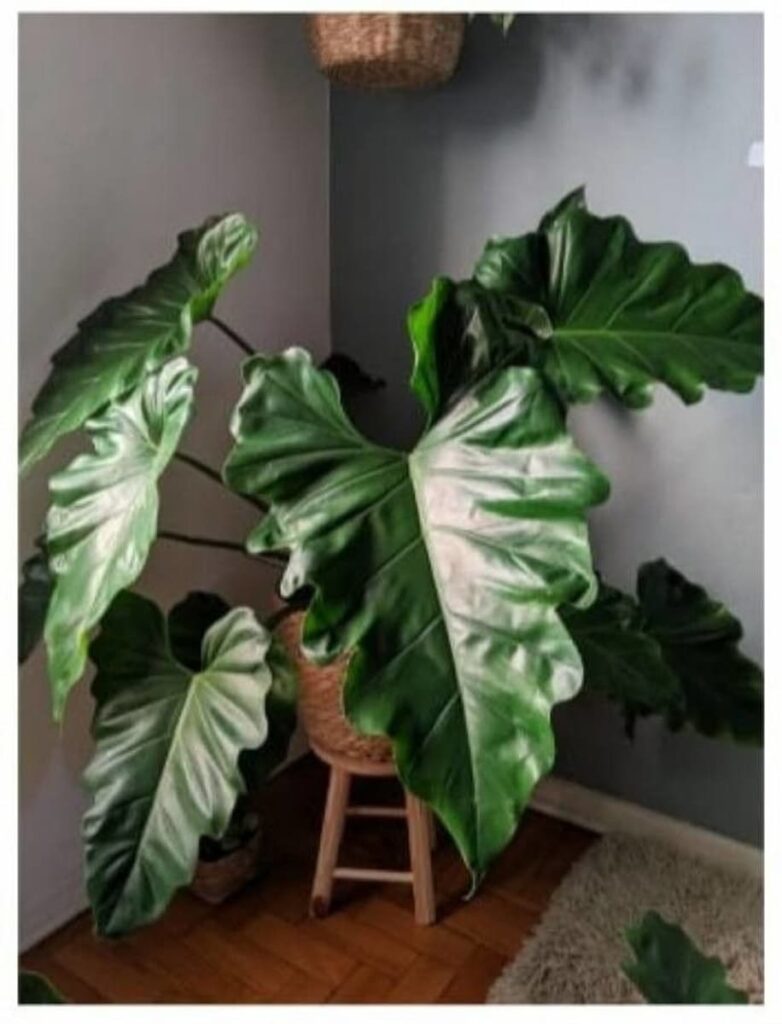
Why are dark patches appearing on the philodendron’s leaves?
If you notice dark patches on your Philodendron giganteum‘s leaves, it could be because the plant has been exposed to cold air. Move the plant to an area where it won’t be exposed to drafts or temperature fluctuations, such as near HVAC vents or exterior doors.
Unfortunately, you won’t be able to remove the dark patches from the leaves, but you can stop new dark spots from occurring. If the patches are extremely noticeable, you can prune off the damaged foliage.
Can I grow the philodendron giganteum outdoors?
Most people cannot grow the Philodendron giganteum outdoors and will need to keep the plant inside as a houseplant. With that said, however, if you live in USDA plant hardiness zones 9 to 11, you can plant this Philodendron variety outside in your garden.
Why isn’t the philodendron giganteum cutting taking root?
Philodendron giganteum is notorious for being hard to root. The best way to propagate this plant is by air layering or using the plantlets if you are lucky enough to have a mature Philodendron giganteum that has produced plantlets. Trying to root this plant using stem or leaf cuttings will usually result in a failed attempt.

Are there variegated varieties of the philodendron giganteum?
There are two variegated varieties of the Philodendron giganteum. ‘Blizzard’ and ‘Variegata’ are the only two variegated varieties currently available. ‘Blizzard’ produces foliage that is light green in color with light yellow stripes, while ‘Variegata’ has a streaky variegation in hues of cream, white, and yellow.
The variegated varieties are considered much rarer than the original plant, which means they are harder to get a hold of and could increase the cost of the plant. Keep this in mind when trying to decide which one you should grow.
Does the philodendron giganteum purify the air?
The Philodendron giganteum is considered an air purifying plant, and research has shown that this plant has the ability to remove toluene, formaldehyde, and xylene from indoor air.
With that said, however, you shouldn’t use this plant as a replacement for air purifiers since the amount of impurities it can remove doesn’t compare with what an air purifier can remove.
What is the best indoor location for the philodendron giganteum?
The best indoor location for this plant is one where it can receive filtered light that isn’t harsh or bright. Direct and harsh sun will damage the plant’s leaves and can even have a negative effect on its overall health. Near a window that gets bright, indirect light is the best indoor location for this plant.
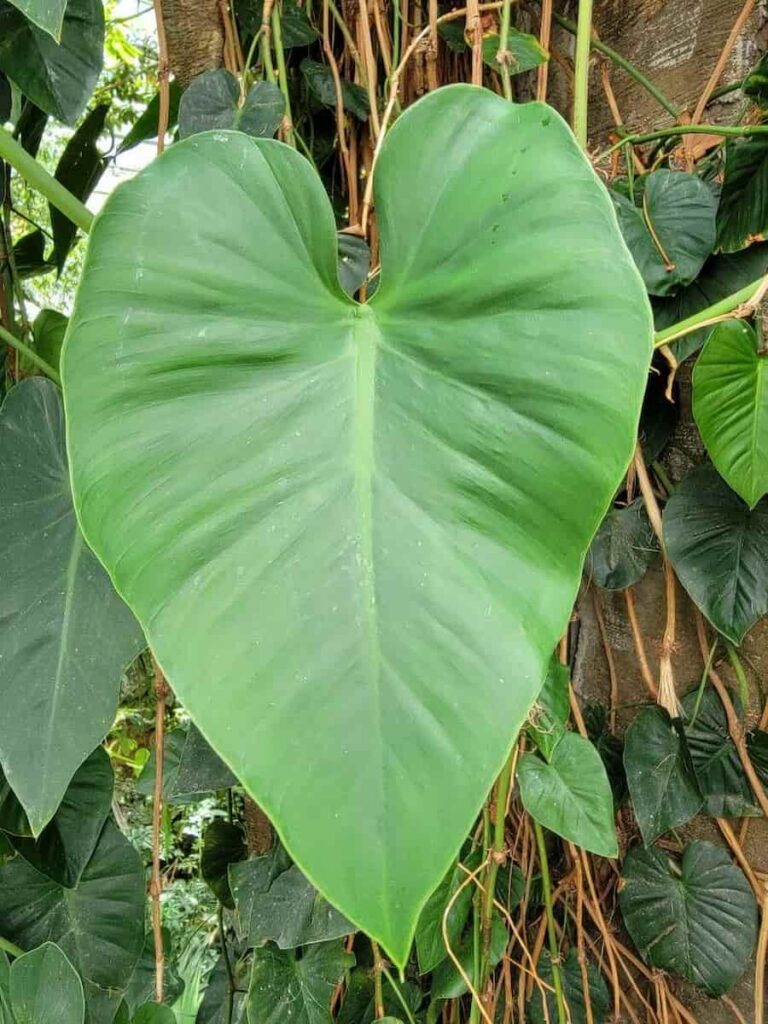
Is the philodendron giganteum drought tolerant?
This plant isn’t drought tolerant, but does grow best when you allow for the top 2 inches of soil to dry out before watering. Not watering the plant when the soil starts to dry out will cause browning of the leaves, leaf drop, wilting, and put unnecessary stress on the plant.
Do philodendron giganteum make good houseplants?
Philodendron giganteum makes excellent houseplants if you are looking for a plant that features large, attractive foliage that can add a tropical vibe to any room. Additionally, this plant is fairly easy to care for, requiring minimal maintenance and isn’t susceptible to many diseases or pest problems.
This plant is a wonderful beginner plant for anyone new to growing plants indoors, and even makes a great housewarming gift.
Does the philodendron giganteum have a dormant period?
This Philodendron variety does have a dormancy period, which occurs during the winter months. At this time, the plant can experience discolored leaves that may even fall off the plant. This is a natural occurrence and nothing to be concerned about.
Additionally, the growth rate of the plant will slow down and the amount of water it needs will be reduced.
